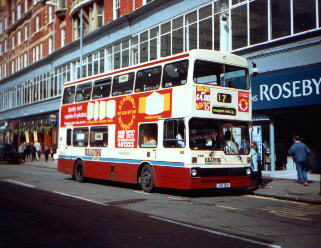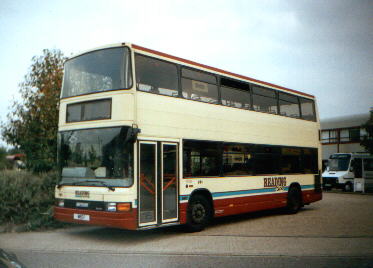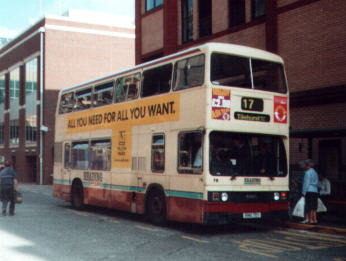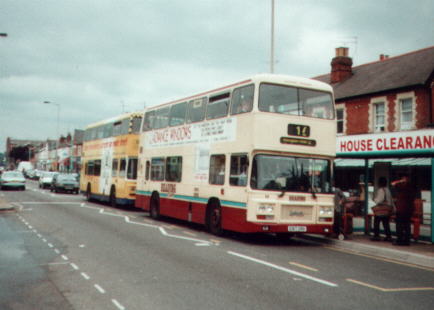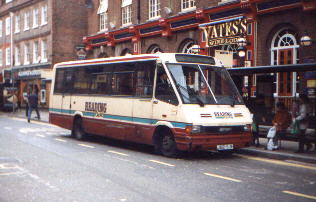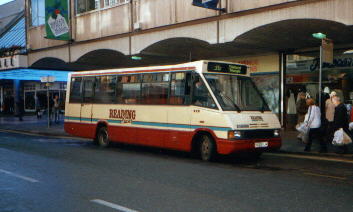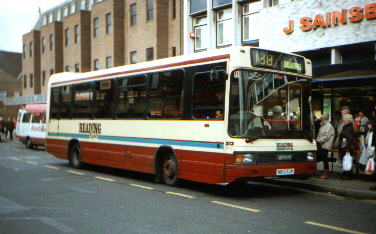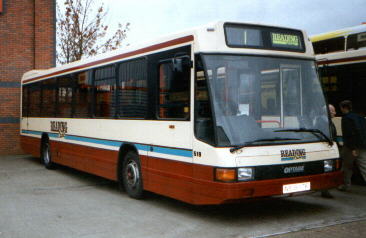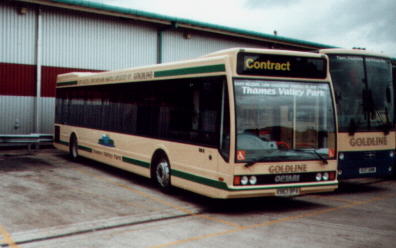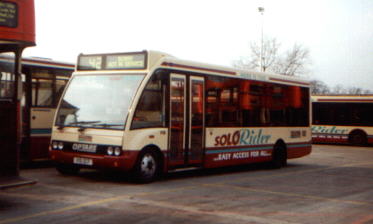What's the Difference?
www.buszone.co.uk
Double Deckers
I thought I would start with the biggest buses. Here we have two double deckers. To the left is what at one time might have been considered a "bog standard" Reading double decker, and to the right one that you might give the same title to now. The left one is in fact a MCW Metrobus, and the right an Optare Spectra. There are a lot of differences. For example the newer bus has a much larger destination display, it has a much more curved look to it, shiney paint, rectangular headlights and curved indicators. They are hardly alike at all, but just to confuse you, these two buses are actually related. The Spectra was based on the designs for the Metrobus, which Optare purchased from MCW many years ago, and so they share a number of common features underneath. They are not the same however just because they are both double deckers.
Some types of bus are harder to tell apart, but are most definitely different, especially underneath. For example the Leyland Titan looks similar to both MCW Metrobuses and Leyland Olympians. The difference between a Titan and Olympian illuded me for a long time when I was starting out. The picture on the left below is of a Leyland Titan and the one on the right is a Leyland Olympian. You can see similarities and importantly differences between all three types. The Titan and Metrobus have black radiator grilles on the front with round head lights, but their indicators are in different places. The bottom of the Titan's front window is flat, but the Metrobus' one has a kink. The Olympian has a similar roof to the Titan, and they both have a Leyland badge on the front but the Olympian has a more curvy front and more stylish head lights. Some of the Titans also have funny small square back windows where the Metrobus and Olympians have normal ones, and the Spectras don't have one at all.
Fleet Numbers
Another difference some people don't seem to understand is the one between a fleet number and a route number. They consider the bus that runs the 103 from Theale to have the fleet number 103, but 103 is not the fleet number it is the number of the route that the bus is operating! Many different buses will operate the 103, the actual bus used is not the same one every day. The easiest way to point this out is the differing registration numbers from day to day, although the bus might look generally the same inside and out, its not going to be the same one every, that's impossible - buses break down! Most bus operators have a numbering system for their buses so that they can easily refer to a specific bus, for example they can then easily specify a bus which needs some repairs, or tell a driver which bus to take out in the morning without confusion. A short number is easier to handle than a full registration number, and the digits on registration numbers can't simply be used because they can be duplicated many times across a fleet of buses. Generally different types of bus are put in different sequences of numbers to make allocating buses easier, for example in Reading all Optare Excel LowRiders are in the 9xx series and standard minibuses in the 6xx series meaning that the people in the office know to put 9xx buses on low floor routes and 6xx buses on minibus routes.
Bus Model Evolution
Some similarities between buses are not by chance. A manufacturer may alter a specific model to make it better. Compare these two minibuses:
Here you might notice that a lot about the two buses looks the same. There is a reason for this, they are the same type of bus, but different versions. First on the left is an Optare MetroRider Mk1 and on the right an Optare MetroRider Mk4. The Mk4 is a later version of the Mk1. You can think about buses like cars, for example there have been many versions of the "Ford Escort", and if two versions are owned by one company it does not make them identical, they still do look different. You have to look past the paint and vinyls sometimes just like you would a car.
Low Floor Buses and Bus Branding
Most people I meet can tell the difference between old and new buses. Reading's newest buses are all low floor, which means there is no step up at the entrance, or until you get to the back of the bus. These buses are specially branded to advertise this, and people can tell the difference. The Reading Buses Low Rider is not the Optare LowRider as you might initially think, it is the Optare Excel. Since they were introduced SoloRiders have appeared. These buses are short minibuses, but are actually called Optare Solos. Here we see new types of bus being marketed to the passenger using their model names. Sometimes the passenger knows more than they think about buses, and sometimes they don't! Previously when the MetroRiders above were introduced to Reading they were branded "GoldRider", and used an adapted version of the Goldline livery as it was at that time. You can now see where some current bus branding comes from.
The Manufacturer
You might notice that many of Reading's buses are produced by Optare. For this reason many types of bus have a family look, MetroRiders, Vectas, Deltas and Spectras all look especially similar:
And so do the newer low floor Excel2s and Solos:
